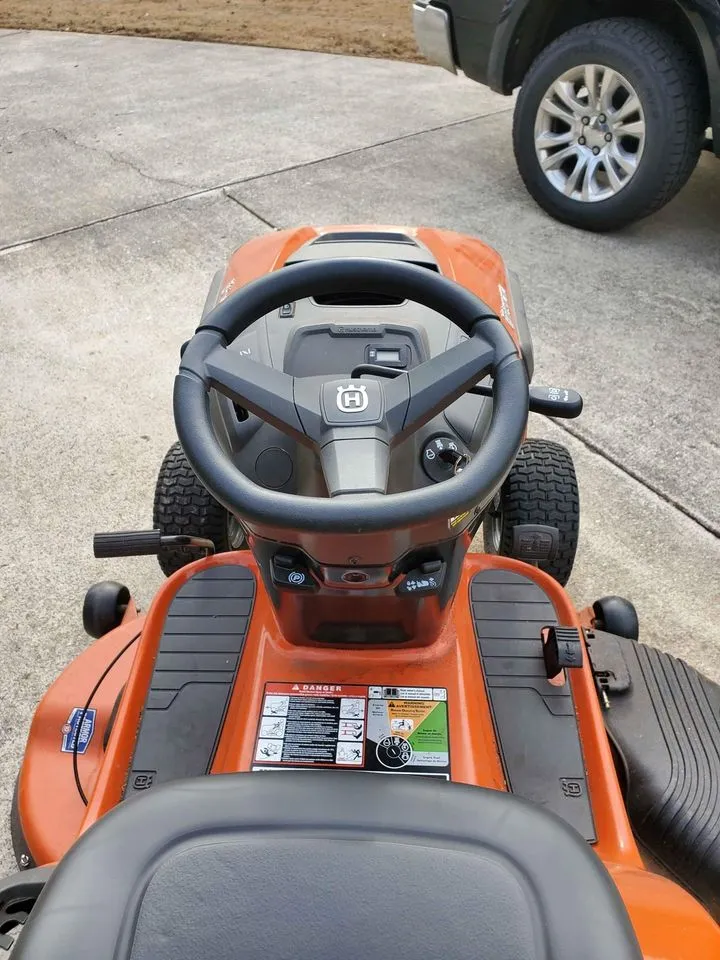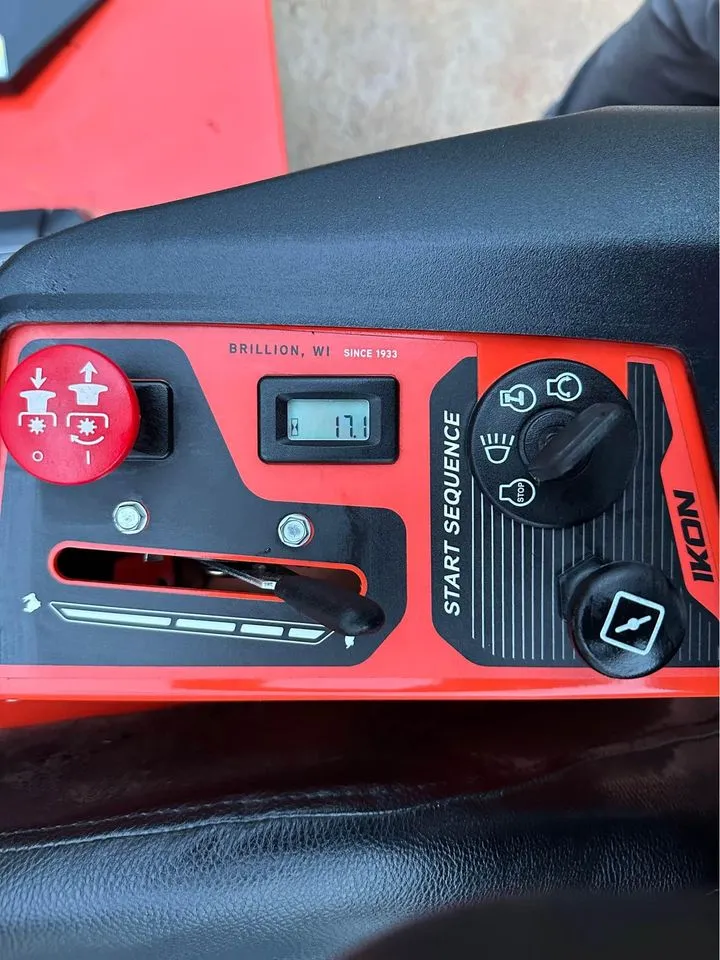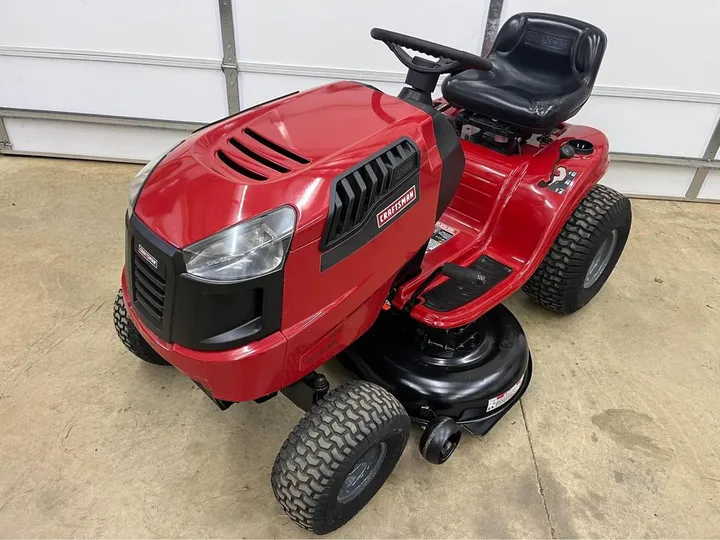Starting a riding lawn mower might seem like a simple task, yet it requires precise steps to ensure both safety and efficiency. As a seasoned expert in lawn maintenance, I’ve mastered the intricacies of lawn mower operation.
My extensive experience guarantees that I have the knowledge to guide you through the process effectively. By following my advice, you can trust that your mower will start smoothly and operate at its best.
Now, let’s dive into the essential steps to starting a riding lawn mower – a critical skill for maintaining a pristine lawn.
Quick Summary
- To start a riding lawn mower, follow key steps including seat adjustment, brake engagement, shifting to neutral, choke positioning, key insertion, and throttle adjustment.
- Regular maintenance, such as checking the starter solenoid and warming up the engine, ensures efficient mower operation and longevity.
- Over 75% of riding lawn mower owners believe that performing regular maintenance contributes to easier startups.
- Personally, I find the process of starting and using a riding lawn mower to be a calming, zen-like experience that enhances my lawn care routine.
Step by Step how to start a riding lawn mower
- Firmly Sit in the Seat: Make necessary seat adjustments for reach and comfort. Fasten safety belts if available.
- Press the Brake: Firmly press the brake pedal to keep the mower stationary.
- Engage the Parking Brake: With the brake pedal pressed, engage the parking brake for added stability.
- Shift Gear to Neutral: Ensure the mower is in neutral to prevent unintended movement.
- Pull Throttle into a Choke Position: If starting a cold engine, engage the choke fully.
- Insert Key in the Ignition: Insert the key, ensuring all safety interlocks are in place.
- Turn the Key to the Right: Turn the key to start the engine, ensuring the battery is in good condition.
- Move Throttle to the Fast Position: Adjust the throttle for optimal engine performance.
How to Start a Riding Lawn Mower
Getting my riding lawn mower up and running isn’t as daunting as it might seem at first glance.
I always start by firmly sitting in the seat, ensuring I’m positioned correctly to reach all controls.
Then, I press the brake and engage the parking brake, setting the stage for a smooth startup.
Related Articles:
- How to Start a Cub Cadet Zero Turn Mower
- How to Start a Toro Zero Turn Mower
- How To Start Bad Boy Mower
Firmly sit in the seat

Before turning the key, I ensure that I’m firmly seated in the mower’s seat, establishing a stable base for operation. Getting this right is crucial, not just for comfort, but for safety too.
I make any necessary seat adjustments so that I can reach all controls without straining. I check that my posture is comfortable, as I’ll be here for a while. Then, I fasten the safety belts, if available, to secure myself properly.
Correct positioning is key to prevent unnecessary fatigue and maintain control. Regular seat maintenance ensures that everything operates smoothly each time.
- Seat adjustments: Tailor the seat to fit my reach and height.
- Comfortable posture: Find a natural, supportive seating position.
- Safety belts: Secure myself for safety and stability.
- Correct positioning: Align myself for optimum control and reduced fatigue.
Next, press the brake
Once I’m comfortably seated, I press down firmly on the brake pedal to ensure the mower remains stationary before starting the engine. It’s crucial to ensure proper brake maintenance to avoid starting problems.
I always check the brake pedal adjustment before I begin; if it’s too loose or too tight, it could lead to issues down the line. I’ve learned that following safety tips, like engaging the brake when starting, is essential for preventing any accidental movements.
If the mower doesn’t start, I consider brake troubleshooting as part of my diagnostic routine. A malfunctioning brake can sometimes prevent the engine from firing up.
And now, engage the parking brake
With the brake pedal firmly pressed, I now engage the parking brake to ensure the mower remains securely in place. This step is crucial for parking safety, especially when I’m preparing to start the mower.
It’s a simple action that has a big impact on the stability of the machine.
- Parking Safety: Engaging the brake prevents any unintentional rolling, keeping me and others around safe.
- Brake Maintenance: Regular checks ensure the brake mechanism is in top condition.
- Operator Presence: This system ensures the mower won’t run if I’m not seated.
- Brake Adjustment: Proper adjustment is key, particularly if I’m on a slope to prevent the mower from slipping.
You have to shift the gear to neutral
Having engaged the parking brake for safety, I now shift the gear to neutral to prepare for starting the riding lawn mower. This step is crucial; the neutral importance can’t be overstated.
It ensures that the mower won’t lurch forward or backward when I turn the key, which is a critical safety precaution.
Before I do this, I always perform transmission checks as part of my routine gear maintenance to make sure the shift mechanism operates smoothly.
If I neglect this, I could face a sticky situation where the mower either doesn’t start or jumps into gear unexpectedly.
Ensuring the mower is in neutral is a simple yet essential practice to keep both myself and the machine safe from unintended movements or damage.
Now, the throttle should be pulled into a choke position
Why is it necessary to adjust the throttle to the choke position before starting a riding lawn mower?
The choke function plays a crucial role, especially during a cold start. It enriches the fuel mixture, ensuring that my mower’s engine gets the right amount of fuel to air ratio when it’s cold and might otherwise struggle to fire up.
Proper engine care includes understanding how your mower works, and using the choke correctly is a big part of that. It’s not just about convenience; it’s about protecting my engine from unnecessary wear.
Here’s what I’ve learned to keep in mind:
- Engage the choke fully for a cold engine start
- Avoid using the choke on a warm engine to prevent flooding
- Gradually push the choke off once the engine runs smoothly
- Regular maintenance includes checking the choke operation
And insert the key in the ignition

If my key ever gets bent or lost, I don’t sweat it; I know where to get replacement keys. Also, I’m mindful of the safety interlock, which won’t let the engine start if everything’s not in the right position.
And lastly, I give a quick once-over to ensure all electrical connections are snug and corrosion-free. It’s all about the details for a smooth start.
Also Read: How to Bypass Ignition Switch on Riding Mower
It is time to turn the key to the right
With the key firmly in the ignition, I’ll turn it to the right to fire up the engine of my riding lawn mower. Before this crucial step, I’ve made sure to perform a thorough engine check.
It’s not just about key insertion; I’ve also confirmed that the battery health is optimal to avoid any start-up issues.
Finally, move the throttle into the fast position
Having checked that the engine is primed and ready, I’ll now move the throttle into the fast position to ensure the mower starts smoothly.
With the choke function engaged, if needed, adjusting the throttle helps the engine receive the right mix of air and fuel. It’s the final touch in a series of deliberate actions that lead up to a successful start.
Starter Solenoid Functionality
The starter solenoid in a riding lawn mower acts as a critical ignition switch, and its proper functioning is essential for starting the mower. If this component is faulty, the mower may fail to start, despite other parts being in optimal condition.
This solenoid is responsible for transferring electrical current from the battery to the motor when the ignition key is turned. Regular checks of the solenoid can prevent starting issues and ensure a reliable ignition every time.
Ignoring this component could lead to frustrating start-up failures, necessitating a thorough diagnostic approach to identify and rectify any solenoid-related problems.
Importance of Engine Warm-Up
Warming up the engine of your riding lawn mower is crucial for several reasons.
Firstly, it allows the oil to circulate properly, ensuring all parts of the engine are well-lubricated for smooth operation. This practice prevents engine damage by allowing internal components to gradually reach their operating temperatures.
Additionally, a proper warm-up can enhance fuel efficiency, as the engine burns fuel more effectively when warmed up.
Not only does it ensure consistent power output for better maneuverability and even mowing, but it also offers an opportunity to spot any issues that might arise, allowing for timely interventions.
Detailed Maintenance Tips

Maintaining your riding lawn mower involves several crucial steps that extend its lifespan and ensure efficient operation. Regularly checking and replacing the oil when it turns black or contains debris is fundamental.
Similarly, cleaning or replacing the air filter is vital to prevent engine clogging. Battery maintenance, including checking terminals and replacing old batteries, is also important.
Keeping the mower deck clean and storing the mower properly when not in use are additional steps that contribute to its longevity and performance.
These maintenance practices not only enhance the mower’s functionality but also reduce the likelihood of unexpected breakdowns and costly repairs.
Pre-Start Checks for Safety and Efficiency
Before starting your riding lawn mower, conducting a series of pre-start checks is essential for both safety and efficiency.
This process includes checking the gas tank to ensure there’s enough fuel, inspecting the oil level, and examining the condition of the tires and belts.
It’s also important to look under the cutting deck for any debris or damage and check the mower’s bagging system for security and proper placement.
If your mower has a roll bar, ensure it’s secured correctly, as some models have an electrical cut-off feature linked to the roll bar.
Lastly, double-check the mowing area and the mower’s parking area to ensure there are no obstacles or hazards that could interfere with safe operation.
Troubleshooting Common Starting Issues
When facing starting issues with your riding lawn mower, a systematic approach to troubleshooting can help identify and resolve the problem. Start by checking the spark plug, as a faulty spark plug can prevent the engine from starting.
Next, examine the fuel level; stale fuel in the tank can hinder starting, especially if the mower has been idle for a long time. The choke position is also crucial; it controls the air intake of the engine and can affect the mower’s starting and running efficiency.
Adjust the choke as needed, ensuring it’s in the fast position when starting and then gradually released as the engine warms up.
If you lose your ignition key, many models have a neutral locate feature that allows for starting without the key, but always refer to the owner’s manual for specific instructions.
Our Verdict
In my experience, starting a good riding lawn mower is much more than just a routine task; it’s the beginning of a gratifying journey towards a well-kept lawn.
I’ve always found that a meticulous safety check and adjusting the seat to my comfort makes a world of difference.
As I turn the key and hear the engine come to life, it’s a reminder of the importance of regular maintenance, which has made every start-up a breeze. The moment the mower starts, I’m not just cutting grass; I’m crafting a space of tranquility.
The rhythmic back-and-forth across the lawn isn’t just work; it’s a surprisingly zen-like experience, transforming the chore into a moment of peace.
So, with each turn of the key, I’m not just starting a machine; I’m unlocking a world of serenity and order in my little green haven.
Frequently Asked Questions
What should you do if your riding lawn mower starts emitting smoke while trying to start it?
If my mower starts smoking, I’d suspect engine overheating, a fuel leakage, or an electrical short. I’d immediately stop it, check the oil level, and perform a maintenance check to identify the issue.
How can you troubleshoot a riding lawn mower that won’t start after winter storage?
To troubleshoot my non-starting mower, I’d check the fuel, inspect the spark plug, clean the air filter, examine the starter solenoid, and ensure the choke is in the correct position.
Can you jump-start a riding lawn mower with a car, and if so, how?
Yes, I can jump-start it with a car, but I must take care to avoid electrical hazards, ensure proper cable connections, and follow battery safety and charging precautions to prevent engine damage.
What are the environmental implications of using a riding lawn mower, and are there eco-friendly alternatives?
I’m exploring the environmental impact of riding lawn mowers, considering their carbon footprint, fuel alternatives, and effects like noise pollution and habitat disruption. I’m also researching maintenance sustainability and eco-friendlier mowing options.
How do you safely dispose of or recycle an old riding lawn mower battery?
I’m ensuring safe disposal of my old mower battery by taking it to a recycling center that manages chemical leakage and battery hazards. I’ve also considered donation options for proper handling and reuse.


